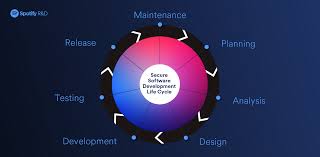Waterfall software development is a traditional approach to software development that has been around for decades. It is a linear and sequential process that follows a set of predefined steps, from requirements gathering to testing and maintenance. In this article, we will explore the advantages and disadvantages of waterfall software development.
Advantages of Waterfall Software Development:
Clear Requirements: The waterfall model requires all requirements to be defined upfront before any development begins. This ensures that everyone involved in the project has a clear understanding of what needs to be delivered, reducing the risk of misunderstandings and errors.
Predictable Timeline: The waterfall model follows a strict timeline, with each phase being completed before moving on to the next. This makes it easier to estimate how long each phase will take and when the project will be completed.
Easy to Manage: Since each phase is completed before moving on to the next, it is easier to manage the project as there are clear milestones that can be tracked.
Disadvantages of Waterfall Software Development:
Limited Flexibility: The waterfall model does not allow for changes once a phase has been completed. This means that if changes need to be made, it may require going back to an earlier phase, which can be time-consuming and costly.
Testing at the End: Testing is typically done at the end of the project, which can lead to issues being discovered too late in the process.
Lack of Collaboration: The waterfall model does not encourage collaboration between team members as each phase is completed separately.
In conclusion, while waterfall software development has its advantages such as clear requirements and predictable timelines, it also has its disadvantages including limited flexibility and lack of collaboration between team members. It is important for organizations to carefully consider their needs before deciding on which approach to use for their software development projects.
6 Tips for Successful Waterfall Software Development
- Start with a plan
- Gather requirements
- Develop design documents
- Test often
- Manage changes carefully
- Document everything
Start with a plan
Starting with a plan is an essential tip for any software development project, especially when using the waterfall model. The waterfall model is a linear and sequential process that follows a set of predefined steps, from requirements gathering to testing and maintenance. Therefore, it is crucial to have a well-defined plan before starting the development process.
A plan should include all the necessary information about the project, such as the scope, requirements, timeline, budget, and resources needed. It should also identify potential risks and how they will be addressed.
Starting with a plan helps to ensure that everyone involved in the project has a clear understanding of what needs to be delivered and how it will be achieved. It also enables better communication between team members and stakeholders throughout the project lifecycle.
Without a plan, it is easy for projects to become disorganized and chaotic. Changes may be made without considering their impact on other phases of the project or on the overall timeline. This can lead to delays, cost overruns, and even project failure.
In conclusion, starting with a plan is an essential tip for successful software development projects using the waterfall model. It helps to ensure that everyone involved in the project has a clear understanding of what needs to be delivered and how it will be achieved. It also enables better communication between team members and stakeholders throughout the project lifecycle.
Gather requirements
Gathering requirements is a crucial step in the waterfall software development process. It involves collecting and documenting all the necessary information about what the software needs to accomplish, how it will be used, and who will be using it. This step ensures that everyone involved in the project has a clear understanding of what needs to be delivered.
One of the main advantages of gathering requirements is that it helps to reduce misunderstandings and errors later on in the project. By having a clear understanding of what is required upfront, developers can avoid making assumptions or guessing what is needed. This can save time and money by preventing rework or changes later on in the process.
Another benefit of gathering requirements is that it helps to ensure that the software meets its intended purpose. By involving all stakeholders in this phase, including end-users, developers can ensure that the software will meet their needs and expectations.
It is important for organizations to allocate enough time and resources for gathering requirements. Rushing through this phase or skipping it altogether can lead to costly mistakes later on in the project.
In conclusion, gathering requirements is an essential step in waterfall software development. It ensures that everyone involved in the project has a clear understanding of what needs to be delivered and helps to prevent misunderstandings or errors later on in the process. Organizations should carefully consider this step when planning their software development projects.
Develop design documents
Design documents are an essential part of the waterfall software development process. They provide a detailed description of the system being developed, including its architecture, functionality, and user interface. Developing design documents is crucial to ensure that everyone involved in the project has a clear understanding of what needs to be done.
Design documents act as a blueprint for the entire project and help to identify potential issues early on in the development process. They also serve as a reference point throughout the project, helping to ensure that everyone is working towards the same goals.
Creating design documents requires careful planning and attention to detail. It is important to involve all stakeholders in the process, including developers, designers, and project managers. This ensures that everyone has input into the design and can provide feedback on any potential issues or improvements.
Design documents should include clear descriptions of each component of the system being developed, including its purpose, inputs, outputs, and dependencies. They should also include diagrams and flowcharts to help visualize how different components interact with each other.
In conclusion, developing design documents is a critical step in waterfall software development. They provide a clear understanding of what needs to be done and help to identify potential issues early on in the process. By involving all stakeholders in the process and creating detailed documentation, organizations can ensure that their software development projects are successful.
Test often
Testing is an essential part of software development, and it is crucial to ensure that the software meets the requirements and functions as intended. In waterfall software development, testing is typically done at the end of the project, which can lead to issues being discovered too late in the process.
To avoid this issue, it is recommended to test often throughout the development process. By testing early and frequently, issues can be identified and resolved before they become more significant problems. This approach can help reduce costs and time spent on fixing issues later in the project.
Testing often also allows for better collaboration between team members. It provides an opportunity for developers, testers, and stakeholders to provide feedback on the software’s functionality and identify any potential issues early on. This collaboration can lead to a more efficient development process as everyone involved has a clear understanding of the project’s progress.
In conclusion, testing often is a critical tip for waterfall software development. By incorporating frequent testing into the development process, teams can identify and address issues early on, leading to a more efficient and successful project outcome.
Manage changes carefully
When it comes to waterfall software development, managing changes carefully is crucial to the success of the project. The waterfall model is a linear and sequential process that follows a set of predefined steps, from requirements gathering to testing and maintenance. This means that any changes made to the requirements or design after a phase has been completed can be time-consuming and costly.
To manage changes carefully, it is important to have a clear understanding of the requirements upfront before any development begins. This ensures that everyone involved in the project has a clear understanding of what needs to be delivered, reducing the risk of misunderstandings and errors.
If changes need to be made during the development process, it is important to assess their impact on the project timeline and budget. It may require going back to an earlier phase, which can be time-consuming and costly. Therefore, it is important to carefully consider whether the change is necessary or if it can wait until after the project has been completed.
Another way to manage changes carefully is by having a change management process in place. This process should include documentation of all changes made, including their impact on the project timeline and budget. It should also include a review process where all stakeholders can provide feedback on proposed changes before they are implemented.
In conclusion, managing changes carefully in waterfall software development is essential for ensuring project success. By having a clear understanding of requirements upfront, assessing the impact of proposed changes on timeline and budget, and having a change management process in place, organizations can minimize risks associated with changes during software development projects.
Document everything
When it comes to waterfall software development, documentation is key. Documenting everything that goes into the project ensures that all team members are on the same page and have a clear understanding of what needs to be done. It also serves as a reference point for future developers who may need to work on the project.
Documentation can take many forms, including design documents, functional specifications, user manuals, test plans, and more. Each document should be clear and concise, with all relevant information included. It should also be updated regularly throughout the project to reflect any changes or updates.
One of the main benefits of documenting everything in waterfall software development is that it helps to reduce misunderstandings and errors. By having a clear record of what has been agreed upon and what needs to be done, there is less chance of team members working on different tasks or misunderstanding requirements.
Another benefit is that documentation can help with future maintenance and updates. If there are changes or updates needed down the line, having clear documentation makes it easier for developers to understand how the system works and what needs to be updated.
In conclusion, documenting everything in waterfall software development is an essential part of the process. It helps to ensure everyone is on the same page, reduces misunderstandings and errors, and makes future maintenance and updates easier. So if you’re embarking on a waterfall software development project, make sure you prioritize documentation from day one!




